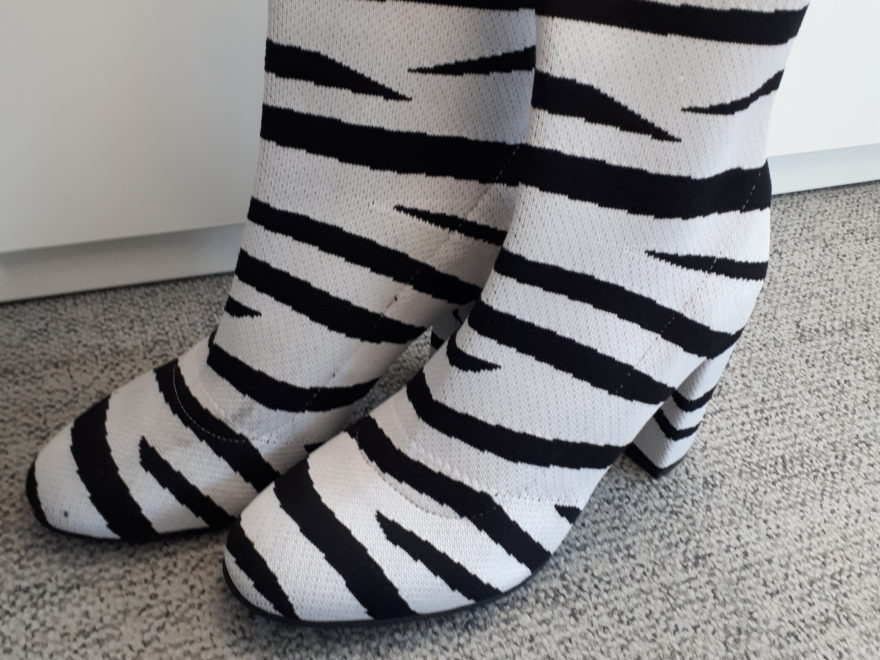Last week I told you why I was so happy to find my brand-new ‘zebra hoofs’ (i.e. boots) at a shoe store’s holiday sale – and the story of how the zebra became a symbol for rare diseases.
Wearing zebra print items is one of the ways in which I raise awareness of rare diseases, including my own. It’s important for me to spread knowledge of these conditions, because when more people know about a disease it becomes more likely that its symptoms and clinical signs will be recognized.
Without recognition of their symptoms, patients with rare diseases often fail to receive an accurate or timely diagnosis. It can take years for someone living with a rare disease to get a diagnosis, so this lack of recognition of ‘zebras’ is an important challenge to address.
During the time that a person is living without a diagnosis, one of two things is probably happening – in terms of their rare disease. A patient with an undiagnosed rare condition is likely to receive either inappropriate treatment(s) based on recommendations for another disease, or no treatment at all.
In many cases their condition simply isn’t recognized; their clinicians aren’t certain that anything is wrong. Either because there are no medical testing or other results to indicate an illness, or because they don’t believe the patient.
So each time I can talk with someone about my own rare disease, I see that as raising the odds that another patient’s symptoms will be recognized more quickly than mine were. That they won’t spend so long wondering whether they’re ‘going crazy’, while waiting for a diagnosis.
How do my new zebra hoofs (boots) help me increase awareness of my disease; Complex Regional Pain Syndrome (CRPS), also still called by its old name of Reflex Sympathetic Dystrophy (RSD)?
Because these boots are hard to miss – striking – I get a lot of comments when I wear them. Each time someone says something about these boots (only positive comments, so far!), I ask if they that the zebra is the symbol for rare diseases… and then we’ll usually chat for a few minutes about rare conditions.
And I’ll mention some of the symptoms and clinical signs of CRPS during each conversation. Maybe someday one of their loved ones or acquaintances will start showing signs of CRPS, and the person with whom I spoke will be able to tell them about this bizarre condition:
complex regional pain syndrome (CRPS) – multiple system dysfunction, severe and often chronic pain, and disability – … has fascinated scientists and perplexed clinicians for decades…”(1)
Because CRPS is considered to be a chronic pain condition, and patients often describe symptoms that are downright bizarre, we are often ‘treated’ with disbelief and disrespect by physicians. I know this to be true, because it’s what happened to me; despite my background in bioethics and even the fact that I used to work at a hospital myself!
Unfortunately, because many patients with CRPS appear “normal” and because pain such as allodynia seems so bizarre and so foreign to most laypeople and even some health care professionals, patients may be mistakenly thought to be either exaggerating their pain for secondary gain or even malingering.
One of the saddest things is that these patients may find their pain discounted by so many others and may be stigmatized as falsifying their discomfort.”(2)
The best way that I can think of, to prevent this from happening to other patients with this rare medical condition, CRPS, is to make more people aware of it… so that patients will someday no longer be treated as though they’re exaggerating.
The individual connections made during these one-on-one conversations help people remember their content. Then they can truly make a difference in spreading knowledge – raising awareness – of rare diseases ,-)
Thanks for reading! As always, feel free to reach our via Instagram or Twitter; the comments have been disabled on my blog because I’d started to receive obscene messages from overseas sources. Life’s too short to deal with that type of thing, so I won’t… Hope you understand!
References
(1) Clinical features and pathophysiology of complex regional pain syndrome. (Review Article.) Johan Marinus, G Lorimer Moseley, Frank Birklein, Ralf Baron, Christian Maihöfner, Wade S Kingery, et al. The Lancet Neurology. 2011(10):7; 637-648. 01 July 2011. doi: 10.1016/S1474-4422(11)70106-5. Accessed 07 Dec 2018:
https://www.thelancet.com/journals/laneur/article/PIIS1474-4422(11)70106-5/fulltext#secd13577181e290
(2) Complex Regional Pain Syndrome. Steven A. King. Psychiatric Times. 23(7). 01 Jun 2006. Online. Accessed 14 Jan 2020:
https://www.psychiatrictimes.com/depression/complex-regional-pain-syndrome

